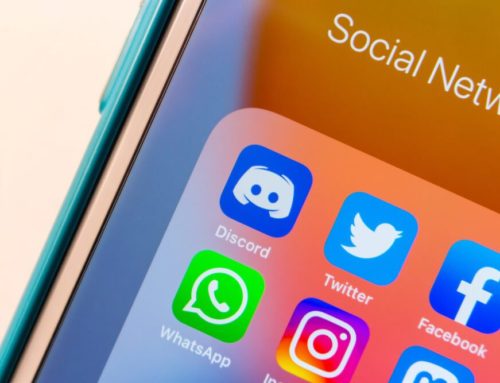Are you wondering how marketing on top social media platforms will change this year?
Social media is constantly evolving to reflect the needs and preferences of customers and marketers alike.
To find out how marketing on Pinterest, Twitter, LinkedIn, and Snapchat will transform in the coming year, we reached out to expert social media professionals to get their thoughts.
#1: Humanization Becomes Key to Success on Twitter
Believe it or not, Twitter turns 11 in 2017, which by social media standards makes it one of the veterans. Over the past few years, we’ve seen it start to get a bit of a bad reputation. With Instagram and Snapchat stealing some of its users, marketers have started to question whether Twitter’s gone stale.
Are Twitter’s days numbered? In our opinion, not at all. Twitter is so ingrained in modern-day life, there’s no chance of it going away anytime soon. As marketers, however, we need to recognize why people are getting fed up with Twitter and adapt our strategies to suit.
We think the businesses and brands that are going to do well on Twitter this year are those that stop using it to blast out one-way communications and start using it to connect with people from across the world to have one-on-one, real-time conversations.
How do you do this, though? Cut back on: 1) the automation, 2) scheduling a week of tweets on a Monday and then never logging back in until it’s time to schedule more tweets, and 3) the hashtag-stuffed tweets.
Did you know that the top three tweets of 2016 contained no hashtags? (OK, one was from a Spanish gamer, one was from Harry Styles, and the third was from a political figure), but our point is people aren’t on Twitter to read #marketing message after #marketing message.
We do think hashtags and content promotion are still key aspects of a good Twitter strategy even this year but don’t rely solely on them. Instead, start conversations. Tell the world what you’re up to, post images like you would on Instagram, use Twitter’s live app to broadcast with Periscope. Most importantly, create tweets that people can easily reply to.
Andrew and Pete, authors of The Hippo Campus, run an award-winning content marketing company where they help small businesses create shareworthy content that builds brands people love.
#2: Snapchat Acquires GoPro to Enhance Live Video
Last September, Snapchat rebranded as Snap, Inc. and quickly proclaimed that it would now be referred to as a camera company and no longer just a social network. Shortly thereafter, the newly formed Snap, Inc. released Spectacles to the masses (sort of).
In the months since, and despite Spectacles reeling in mixed reviews, rival Facebook has upped the ante for social media market share by rolling out live video capabilities on Instagram, whose user demographic closely aligns to Snapchat’s. Plus Facebook added Snapchat-like features to its Messenger product.
Facing an IPO, as well as pressure to stave off Facebook and Twitter, Snap, Inc. (a.k.a. “Snapchat”) will introduce its own set of live-streaming features that will make live video more appealing and mainstream to younger audiences, much in the way Musical.ly has helped introduce live video to them. Although Snapchat will have built-in disappearing live video similar to Instagram, it will need to create more of a “sizzle” to keep investors on Wall Street happy.
Therefore, I boldly predict that for Snap, Inc. to create legitimacy as a camera company and to grow revenue beyond advertising, it will acquire GoPro and its millions of enthusiasts in the process. A Snapchat and GoPro merger is a win-win in every sense of the word for Snapchat and users, who would then be able to share stunning, HD-quality content to Snapchat from their GoPro device without the aid of an iPhone.
Carlos Gil is the global head of social media for BMC Software.
#3: Pinterest Pushes Video Pins Into Prominence
I believe Pinterest will try to move video and video ads to the forefront of the platform. Because video feels a bit like a speed bump in the user experience, marketers will need to test whether loading video to off-platform landing pages or directly to Pinterest works best for their audience.
Kate Ahl is the owner of Simple Pin Media, a Pinterest management company.
#4: Twitter Remains Relevant
Twitter is an enigma. It’s not the biggest channel or the most popular, but it’s undeniably part of the fabric of our lives.
While some may foresee the demise of Twitter, I don’t. Twitter has a huge, passionate user base. It’s the place where news breaks and tweets have become a centerpiece of popular culture and politics.
Twitter has a bright future, but probably not as an independent company. It’s a goldmine of data and belongs in a data-hungry company somewhere.
Mark Schaefer is the author of The Tao of Twitter.
#5: Snapchat Spectacles Feature AR/MR Shopping
Point of view content will be huge for brands, marketers, and influencers in 2017.
Snap will roll out Spectacles 2.0, which will include some element of AR/MR. This feature will signal a push toward AR/MR-enabled shopping and we’ll begin to move away from doing everything through our mobile devices and start to do it through wearables like Spectacles.
Cathy Hackl, a nationally recognized live video, and VR/AR influencer and speaker, is one of the nation’s top Latino digital influencers and tech innovators.
#6: Platforms With Customer Service Features Will Flourish
Social media customer service will become a primary way customers interact with the companies they do business with. This really isn’t a prediction as much as it’s a continuing trend. However, the trend is moving social media channels like Twitter, Facebook, YouTube, and others from being an alternative channel for customer service to the primary channel.
It’s been said that customer service is the new marketing, so it makes sense that social customer service is being recognized as the new social media marketing. First, we must dispel the idea that customer service is a department. It’s not. Tradition says that customer service is a department that reacts to complaints and problems.
No, customer service is a philosophy to be embraced by every person in a company, from the CEO to the most recently hired. And one of the most powerful places customer service can exist is in a social media marketing strategy. That’s why my prediction that the above-mentioned social channels, basically any social channel that gives the customer a voice, will become even more relevant in 2017.
Just last year, Social Media Marketing World had an entire track devoted to Social Customer Care. (Thanks to Dan Gingiss and his team for putting this together.) Special presentations by Jay Baer on how social media is a great opportunity to showcase customer service, Jeff Lesser on how Twitter is using their channel for support, and other speakers and panels showcased the power of social in customer service. And this year, that track will be bigger and better.
Just as companies can no longer discount the power of social media (and I can’t believe that some of them still don’t get it), they also can no longer discount the power of bringing their customer support to the traditional channels that have primarily been known for social communication.
Shep Hyken is a customer service and experience expert, an award-winning keynote speaker, and a New York Times bestselling business author (@hyken).
#7: Twitter’s Acquisition by Media Outlet Possible
As Twitter blossoms more fully into a media resource, the likelihood that it will be purchased by a media outlet in 2017 increases. In addition, I believe live video via Twitter Live will also play an integral role in the company’s future.
For now, marketers should remember that Twitter is still a primary traffic source for blog content and continue to share their content there.
Kim Garst, co-founder and CEO of Boom!, is a bestselling author of Will the Real You Please Stand Up: Show Up, Be Authentic and Prosper in Social Media.
#8: Snapchat’s Significance Wanes
I’ve always had Snapchat hanging out on the back burner; people talk about it and kids raved about it years ago. More recently, marketers started to rave about it and I thought to myself, “Is Snapchat something I should pay more attention to?” I’ve decided the answer is no.
Snapchat does have a cool vibe to it and was arguably the first platform that allowed you to connect intimately with your audience in a unique, short, and fun way via actual audio and video story bits. While the platform provides a unique opportunity for those willing to get to know it and for those who already have a huge following there, it hasn’t evolved fast enough.
Instagram has evolved with Instagram Stories. Instagram saw what Snapchat created, mimicked it, and made the user experience 10 times easier.
My advice to businesses looking for a platform to help them connect intimately with their audience is to stick with Instagram. In a couple of years, I don’t think marketers will be talking about Snapchat anymore.
Kate Erickson is a creator, engager, and implementer at EntrepreneurOnFire, a podcast that interviews today’s most inspiring and successful entrepreneurs.
#9: Twitter Marketers Shift Focus From Driving Traffic to Creating Connections
The recent changes Twitter has made, including the addition of an algorithm, mean that Twitter is the social network marketers most need to change their approach to.
It’s time to go back to the days when Twitter wasn’t just automated noise. Twitter can still be used to drive traffic but is becoming even more effective as a connection tool.
To adjust, marketers will need to tweet less but with more quality, with the goal of tweeting to connect with others and create interaction.
Erik Fisher is a podcaster and manager of the Social Media Examiner social team.
#10: Live Streaming on LinkedIn Improves Targeted Selling
In 2017, if LinkedIn enables live-streaming video, it will become a game-changer for B2B marketers. Companies will be able to target specific audiences with live content focused on specific business needs, broadcasting to a verified lead your sales team can follow up with.
As long as the content is interesting and engaging, your audience will tune in and help build a community for your brand. But to be successful, marketers must rethink their content strategy.
For example, evolve the traditional webinar. Instead of PowerPoints, use live video to demo your product. Create a weekly live video show. Find an employee to interview customers and tell the story of how your brand helps people.
Above all, be in the moment, be real, and be authentic.
Ursula Ringham is director, digital marketing at SAP, where she drives the live video and social media strategy for small- and midsize enterprise.
#11: Twitter Becomes a Content Destination
My prediction for Twitter in 2017 is that we’ll see the rebound of this fantastic platform from 2016, which was filled with speculation. Fueling that growth will be the continued rise in content consumption directly within the Twitter platform, a focus on improving the Twitter feed algorithm, and marketers winning with quality over quantity.
We’ve already seen some of this come to life when Twitter reached a live streaming deal for 10 games with the NFL. Twitter also made a great move to allow people and brands to go live directly within the app, without having to download Periscope separately.
All of this leads up to Twitter becoming a content destination, rather than a means to an end.
Marketers can adapt by first understanding that Twitter is no longer a platform used solely for driving traffic to an external blog or website. We’ve seen brands and companies experience a steady decline in organic traffic from Twitter over the last several months, leaving many wondering if they should continue to use the platform. Or they continue to implement the same Twitter marketing strategies that worked 2 or 3 years ago.
Marketers who apply a multi-pronged approach, treating Twitter as a content destination, will keep their audience coming back for more.
This approach includes uploading native video content, live streaming, sharing images, photos, infographics, charts, data, GIFs, and text-only tweets in addition to tweets with links to your website. In other words, a focus on quality and increasing your organic reach, not simply the quantity of tweets sent, is a great way for marketers to adapt to this new age of Twitter marketing.
Brian Peters is the social media manager at Buffer and a host of The Science of Social Media podcast.
#12: LinkedIn, Twitter and Snapchat Focus on Live Video Across the Board
In 2017, I look for LinkedIn to become more Facebook-like, moving away from its professional look. The platform will make it easier to create content for the people you are connected with, and will look at integrating some form of live stream ability
Twitter will also invest further into live video. They’ll pour more money into Periscope by adding VR and 360 to the live stream app. I think a purchase of Twitter is then likely.
Along the same lines, Snapchat will either purchase or build a live stream arm into its platform, and will possibly buy GoPro or the Hype app. As more small brick and mortar businesses see they can use Snapchat to get more foot traffic into their store, they’ll start using it more.
John Kapos is creator at and owner of Perfection Chocolates in Australia. Known online as Chocolate Johnny, he’s very active on Periscope, Facebook, Instagram, Snapchat, and Twitter.
What do you think? Which of these predictions is most interesting to you? How will you change your marketing plans to adjust for these changes when and if they arrive? Please share your thoughts in the comments below.










